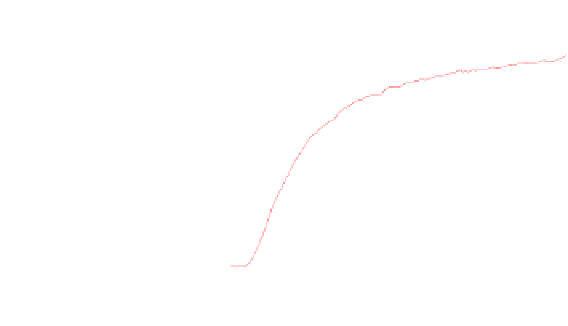Information Technology Reference
In-Depth Information
1 5
DURING
BEFO
RE
AFTER
R
∅
1 3
1 2
1 1
1
min{R(t)}
0 9
0
20
40
60
80
100
120
140
160
180
Time (sec)
Fig. 3.
Example of a MOS sensor response. Each measure consists of three main stages:
before each measure the instrument inhales the reference air, showing in its graph a
relatively constant curve; after this short period it inhales the analyzed gas, producing
a change of the sensor resistance; finally the instrument returns to the reference line,
ready for a new measure.
thickness and is usually longer than MOS response time; moreover they suffer of
response drift over time and their response is more susceptible to humidity than
MOS sensors are.
Theelectronicnosewehaveusedinthis research is composed of an array of
six MOS sensors. This choice is due to the fact that, as previously mentioned,
MOS sensors are characterized by high sensitivity, low cost, high speed response
and a relatively simple electronics. The first aspect takes on great importance
if we consider that most of the VOCs markers of lung cancer are present in the
diseased subject breath in very small quantities, varying from parts per million
to parts per billion. A typical response of a MOS sensor is shown in Figure 3.
Piezoelectric sensors.
The piezoelectric family of sensors can measure tem-
perature, mass change, pressure, force and acceleration, but in the electronic
nose they are configured as mass change sensing devices. There are two main
types of piezoelectric sensors used in electronic noses: Quartz Crystal Microbal-
ance (QCM) and Surface Acoustic-Wave (SAW). The measured variable in both
devices is the resonant frequency, that changes according to mass. A drawback of
both QCM and SAW devices is a more complex electronics than the electronics
needed by chemoresistors sensors as well as the need for frequency detectors,
whose resonant frequencies can drift over time. Even if SAW sensors operate at
higher frequencies than QCM (and thus generate larger changes in frequency),
their measure of mass change is of the same order of magnitude (1.0 ng mass
change). SAW sensors are usually characterized by a poor long-term stability
and a high sensitivity to humidity.













































Search WWH ::

Custom Search